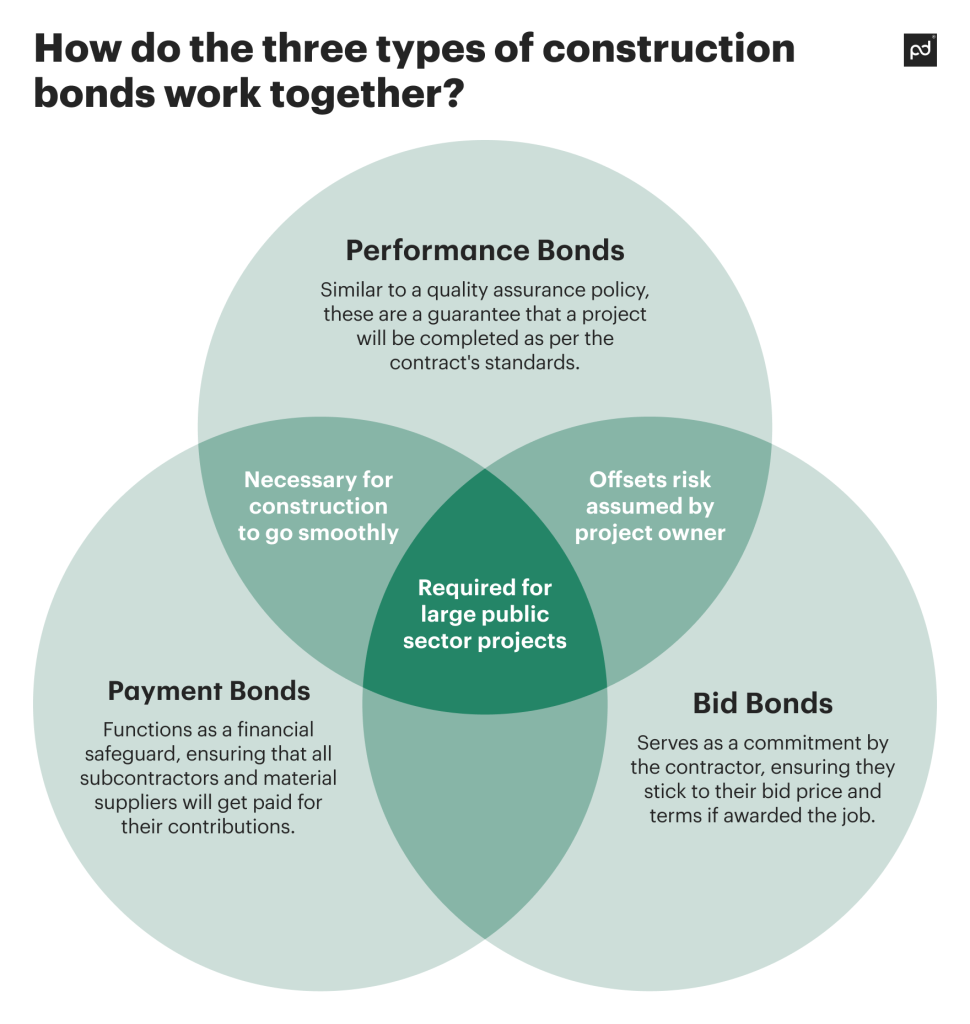The terms “contract bond” and “performance bond” refer to types of surety bonds used in construction and other contract-based projects, but they serve different purposes.
While a contract bond is a broad term covering various types of bonds ensuring overall contract fulfillment, a performance bond is specifically focused on the completion of the work as per the contract’s standards and specifications.
Key takeaways
- Performance bonds serve both as a legal obligation and a trust-building tool for project owners, demonstrating the contractor’s ability to complete the project.
- The cost of a performance bond is usually not higher than 3% of the contract amount, and the contractor typically adds this cost to their bid estimates.
- If a contractor fails to fulfill their obligations, the performance bond-issuing surety should arrange for project completion with another contractor or compensate the project owner.
What is the role of contract bonds in construction projects
Contract bonds are like a safety net, guaranteeing that a principal (the contractor) will fulfill their contractual obligations to the obligee (property owner).
This broader category spans several types of bonds, with these three being the most essential:
- Bid bonds. Serves as a commitment by the contractor, ensuring they stick to their bid price and terms if awarded the job.
- Performance bonds. Similar to a quality assurance policy, these are a guarantee that a project will be completed as per the contract’s standards.
- Payment bonds. Functions as a financial safeguard, ensuring that all subcontractors and material suppliers will get paid for their contributions.
All contract bonds are a form of surety bonds, crucial in managing risk and fostering trust in construction projects.
The term refers to financial assurances provided to the project owner by a third party — the surety.
What is a performance bond
Performance bonds protect the project owner from financial losses by providing a guarantee: the contractor is committed to follow through on the project — to perform — as expected.
Failure to do so and the surety company (third-party issuing the bond) will be required to find another contractor.
But why do contractors need a performance bond at all?
These bonds are required to bid on certain projects, particularly large or public ones.
They guarantee the contractor’s reliability, financial stability, and capacity to adhere to the contract terms and deliver a completed project as planned and on time.
How do performance bonds work
Performance bonds create a three-way relationship between contractors, property owners, and surety companies.
Contractors’ role
A contractor or principal is at the heart of a performance bond.
They purchase the bond as a pledge to fulfill their duties under the contract, conferring their commitment and capability to see the project through to the end.
Property owners’ role
Property owners or obligees are the clients who initiate construction projects.
They need a performance bond to secure their investment and guarantee they won’t have to bear unnecessary delays or losses.
Surety companies’ role
The surety companies or bond issuers bring trust into the equation.
They assess the contractor’s ability to deliver on their promises and only after that issue a bond.
If the contractor fails to fulfill the contract, the surety company steps in to arrange for another contractor to take over the project or via other suitable means.
When is a performance bond required
Performance bonds are more than just a keystone in the architecture of trust and reliability — they’re also a requirement.
If the contractor operates in the USA, they must abide by federal laws that state that a prime contractor on most federal construction projects must furnish payment and performance bonds, each with a value equivalent to the contract price.
So, the requirement for performance bonds is particularly prevalent in the following cases:
- Contractors for government-funded projects must ensure the responsible use of public funds and the successful completion of infrastructure and other public works.
- Federal construction projects under the Miller Act require performance bonds from all prime contractors on any project over $100K.
- Private sector projects, although not universally mandatory, may also require performance bonds to protect project owners from related financial risks.
Performance bonds can often be paired with payment bonds, especially with public projects that require strong guarantees of financial protection for all parties.
What is the amount of a performance bond, and what does it cover
Think of the performance bond as a contractor’s promise that can shield the project owner from losses.
It ensures that the project will be completed even in case the first contractor fails to complete the project or in the event of the contractor’s bankruptcy.
The bond provides financial protection and typically covers 100% of the contract value.
The cost of a performance bond is generally 1% to 3% of the bond amount, and contractors often include this cost in their bid estimates.
Imagine a contractor who has just won a contract to build a school valued at $1 million.
To start the project, the contractor needs to get a performance bond to assure that taxpayer-funded projects will get completed as intended.
The rate a contractor needs to pay for a performance bond depends on several factors, including the contractor’s financial health, experience, and the size of the bond, and can be around 2% of the bond amount.
If a contractor is working on a $1 million project, the cost of the performance bond at a 2% rate would be $20,000.
What is needed to obtain a performance bond
To obtain a performance bond, a contractor is normally required to submit a set of documents and items:
- An application that includes basic information about the contractor and the project.
- Financial statements offering a snapshot of the contractor’s financial health, including assets, liabilities, and cash flow.
- A credit check and a good credit score to demonstrate the contractor’s creditworthiness.
- Project details that help the surety understand the scale and risk associated with the project.
- Experience as well as company résumé to demonstrate the contractor’s track record and ability to successfully manage and complete similar projects.
- References from previous clients, business partners, or financial institutions that validate the contractor’s reliability and quality of work.
- Banking information, including details about the contractor’s banking relationships and financial resources.
- Bond premium payment, typically a percentage of the total bond amount.
Contractors should be always prepared to provide the surety company with comprehensive documentation and financial details.
To assist with this, they can use the PandaDoc content library and customizable templates to create and manage various documents and make communication among all parties efficient.
After saving existing content from templates and documents directly into the library, users can later enjoy easy access to the right content when needed.
This library is a time-saving tool that helps users ensure consistency across various documents.
How do the three types of construction bonds work together
There are three key types of bonds in construction, and each bond type is integral to different stages of a construction project.
Large public construction projects, especially those funded by tax-payers, typically require all three types of bonds, which strengthen financial and contractual security throughout the project lifecycle.

What happens if a contractor defaults on a project
When a contractor fails to meet their obligations, both the owner and the surety that issued the bond undertake responsibilities.
That means they must deal with the actions the project owner takes against the bond.
The project owner will typically file a claim with the surety company that issued the bond.
The surety company then investigates the situation to determine if the contractor has indeed defaulted.
If they confirm the default, the surety can arrange for another contractor to complete the project or provide financial compensation to the project owner.
This scenario protects the project owner from the risk of ongoing project delays and financial losses.
Tackle all your contracting needs easily with PandaDoc
PandaDoc offers an extensive suite of tools for contract management in the construction industry, proposal creation, contract negotiation, and more.
With PandaDoc’s customizable templates, users can easily create and electronically sign documents like contract bonds or quotes, addressing a range of contracting needs in construction.
Explore more about PandaDoc’s construction industry solutions, contract management software, and proposal software for in-depth insights and templates!
Disclaimer
PandaDoc is not a law firm, or a substitute for an attorney or law firm. This page is not intended to and does not provide legal advice. Should you have legal questions on the validity of e-signatures or digital signatures and the enforceability thereof, please consult with an attorney or law firm. Use of PandaDoc services are governed by our Terms of Use and Privacy Policy.


